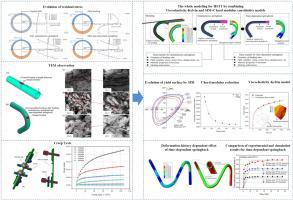Journal of Materials Processing Technology ( IF 6.3 ) Pub Date : 2021-09-01 , DOI: 10.1016/j.jmatprotec.2021.117354 Heng Li 1, 2, 3 , Liwen Zhang 1, 2, 3 , Guangyao Chen 1, 2, 3 , Jun Ma 1, 2, 3 , Dong Wei 1, 2, 3 , Tianjun Bian 1, 2, 3 , Jinchao Yang 1, 2, 3 , Changhui Wu 1, 2, 3 , Heng Yang 1, 2, 3

|
Although time-dependent springback is minor compared with instantaneous springback, its deformation-history dependent effects may deteriorates the compactness of parts assembly and poses potential hazards to the safety and stability of the equipment systems especially under harsh service conditions. However, time-dependent springback still has not been paid enough attention, and how to accurately predict this phenomenon is still a challenge needed to be solved urgently. In this work, taking high-strength Ti-3Al-2.5V titanium tubular materials (HSTT) upon bending as a case, the experimental exploration of the physical mechanisms and the prediction modeling for time-dependent springback of the HSTT were conducted. First, the residual stress and dislocation evolution of HSTT during bending, instantaneous springback and time-dependent springback are comprehensively experimentally obtained, and the compression-tension uneven residual stress-driven creep deformation mechanism of time-dependent springback for HSTT was revealed. Then, considering stress attenuation, a Viscoelastic-Kelvin constitutive model for time-dependent springback was developed and combined with the stress invariant-based model (SIM) and Chord modulus model to accurately predict the whole process of bending, instantaneous springback and time-dependent springback of the HSTT. Finally, the verified model is employed to explore the evolution rules of time-dependent springback and residual stress of HSTT upon bending, and the deformation-history dependent effects of time-dependent springback for spatial multi-bending component are clarified. The findings and methods of this study could aid in achieving higher precision manufacturing of high performance tubular components.
中文翻译:

高强度钛管材料的瞬态回弹:实验与建模
尽管与瞬时回弹相比,时变回弹较小,但其变形历史依赖效应可能会降低零件装配的紧凑性,并对设备系统的安全性和稳定性构成潜在危害,尤其是在恶劣的使用条件下。然而,瞬态回弹仍然没有得到足够的重视,如何准确预测这种现象仍然是一个亟待解决的挑战。本工作以高强度Ti-3Al-2.5V钛管材(HSTT)弯曲时为例,对其物理机理进行了实验探索,并对HSTT的瞬态回弹进行了预测建模。首先,HSTT在弯曲过程中的残余应力和位错演变,综合实验得到瞬时回弹和时变回弹,揭示了HSTT时变回弹的压拉不均匀残余应力驱动蠕变变形机制。然后,考虑应力衰减,建立了瞬态回弹的粘弹性-开尔文本构模型,并结合基于应力不变的模型(SIM)和弦模量模型,准确预测了弯曲、瞬时回弹和瞬态回弹的全过程。 HSTT 的回弹。最后,通过验证模型探索了HSTT弯曲时随时间变化的回弹和残余应力的演化规律,阐明了时间相关回弹对空间多弯曲构件的变形历史影响。


























 京公网安备 11010802027423号
京公网安备 11010802027423号